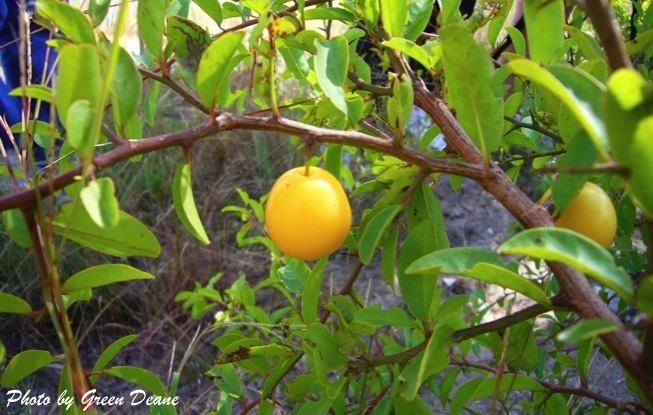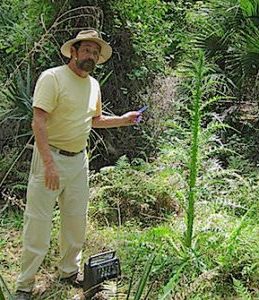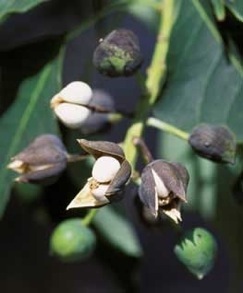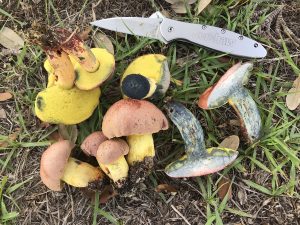
Tallow plums ripen to yellow, and sweeten. Photo by Green Deane
It will be a few months before we can eat them because the tallow plum is setting fruit. Sweet with a hint of lemon when ripe we’ll start finding ripe ones near the end of summer. A commercial fruit in other parts of the world, it is a very under utilized wild food locally. (My picture of an unripe fruit and blossom would not load.)
Tallow Plum, Ximenia americana, is a native shrub that many rangers and grounds keepers don’t recognize, thus it is often removed when an area is cleared of “non-native” species. Also little is known about the species, such as whether it is a clone, parasitic or semi-parasitic (on oaks and pines.) It has also been called the American plum, blue sour plum, monkey plum, mountain plum, seaside plum, Spanish plum, wild plum, hog plum, and yellow plum though it is not a plum but its leaves can be bluish. Other names include pepenance, coastal prune, spiny prune, Brazilian apricot, spiny apricot, wild apricot, little apricot and little wild apricot though it is not a prune nor an apricot. Then there is ocean cherry, wild cherry and cherry — no, it is not a cherry either; sea lemon, seaside lemon, wild orange, and wild lime…and no it is not a citrus. Others prefer devil’s apple, fiddle apple, little apple and wild quince. Yes, you guessed it again: It is not an apple or any apple relative. Some even call it the Wild Olive. No, it is not related to the olive but it is in the Olax family. Olive/olax… tenuous at best. There is also a darker side with names like purge-nut, cagalera (diarrhea) and fransman moppe (Frenchman’s complaint) a reference to what too many of the seeds can do.
It got the name Tallow Plum because of the waxy texture of the fruit. Botanically it is Ximenia americana (that’s hem-MAY-nee-uh a-mer-ih-KAY-na.) It was named for the Spanish monk Francisco Ximenez, a native of Luna in the Kingdom of Aragon. Americana means of the Americas.

Chickasaw Plums are starting to ripen. Photo by Green Deane
Chickasaw plums are usually out of season by the fourth of July, but this year things are a bit late so the fruit is still ripening on the tree.
In the 1800’s there was great interest in making cultivars out of native plums (as they did apples) and by 1901 there were over 300 of them. But mechanization of fruit production in the early 1900’s led growers away from the native varieties though there has been some interest of late to use the native plums again as a high-value specialty crop.
Besides man the Chickasaw Plum’s fruit is eaten by deer, bear, fox and raccoon. The thorny thicket is valuable for songbird and game bird nesting including the bobwhite and mockingbird. It also makes a good wind break and can be used for erosion control. The plum, extensively used, was taken where ever the Chickasaw people went. It has many local names. While usable, the Flatwood Plum, is not prime foraging food. Its quality can vary from tree to tree, rarely rising to the gustatory level of the Chickasaw Plum. The American Plum was also used by the natives.

Foraging classes are held rain, shine, hot or cold. Photo by Nermina Krenata
Foraging Classes: The schedule is hopeful as we dodge hurricanes this time of year.
Saturday, July 6th, Blanchard Park, 2451 Dean Rd, Union Park, FL 32817, meet by the tennis courts. 9 a.m. to noon.
Sunday, July 7th, John Chestnut County Park: 2200 East Lake Road, Palm Harbor, FL 34685. Meet at the trail head of the Peggy Park Nature Walk, pavilion 1 parking lot, 9 a.m. to noon.
Saturday, July 13th, Mead Garden: 1500 S. Denning Dr., Winter Park, FL 32789. Meet at the bathrooms. 9 a.m. to noon.
Sunday, July 14th, Bayshore Live Oak Park, Bayshore Drive. Port Charlotte, Meet at Bayrhore and Ganyard Street. 9 a.m. to noon.
Saturday, July 20th, Spruce Creek Park, 6250 Ridgewood Ave. Port Orange. Meet at the pavilion , 9 a.m. to noon.
Sunday, July 21st, Wickham Park: 2500 Parkway Drive, Melbourne, meet at the dog park. 9 a.m. to noon.
For more information on these classes, to prepay or sign up go here. The cost is $30 per adult (the class is usually three hours long and examines five-dozen or so species.) If cost is a hardship email me at: GreenDeane@gmail.com.
 Is it edible? Yes, no, maybe… The Chinese Tallow tree is both banned and championed. It’s edibility is also linked to why it’s even in the United States to begin with. The tree was imported by none other than Ben Franklin (well… he sent some seeds to a friend.) The purpose was to use the white external seed fat for making candles which used beef suet, tallow. Hence the tree’s name in English. In theory the coating of saturated fat on the outside of the seed is edible. It is also very stable. But there are two problems. It can be very difficult to remove and inside the seed there is an oil toxic to humans. So the fat and the oil should not mix. Some people have experimented with crushing the entire seed and heating the mash thus melting the saturated fat along with releasing the toxic oil. When they cool the edible fat and the non-edible oil separate, the edible fat turning solid, the seed oil remaining liquid. In China, where the tree is valued, the white saturated fat is steamed off the seed. The tree, while an invasive species in some areas of North America — such as Florida — is being considered as a good candidate for bio-fuel. You can read my article about it here about it here. A later magazine article about the species is here.
Is it edible? Yes, no, maybe… The Chinese Tallow tree is both banned and championed. It’s edibility is also linked to why it’s even in the United States to begin with. The tree was imported by none other than Ben Franklin (well… he sent some seeds to a friend.) The purpose was to use the white external seed fat for making candles which used beef suet, tallow. Hence the tree’s name in English. In theory the coating of saturated fat on the outside of the seed is edible. It is also very stable. But there are two problems. It can be very difficult to remove and inside the seed there is an oil toxic to humans. So the fat and the oil should not mix. Some people have experimented with crushing the entire seed and heating the mash thus melting the saturated fat along with releasing the toxic oil. When they cool the edible fat and the non-edible oil separate, the edible fat turning solid, the seed oil remaining liquid. In China, where the tree is valued, the white saturated fat is steamed off the seed. The tree, while an invasive species in some areas of North America — such as Florida — is being considered as a good candidate for bio-fuel. You can read my article about it here about it here. A later magazine article about the species is here.

Edible Boletes. Photo by Green Deane
Mushroom hunters like to say all boletes in Florida are edible, including the Pulchroboletus rubricitrinus. (Most mushrooms do not have common names.) This red-capped bolete stains blue, has a slightly tart flavor and no netting on the stem, that’s important. The stem can have dots or smears but no netting. It likes sandy soil and grows in oak or oka-pine woods. Drops of household ammonia turns the cap skin olive colored. This bolete is a common find in lawns in Texas and Florida.
Tired of Facebook and want to identify a plant? The Green Dean Forum is up and running again. Have you come to dislike Facebook, then join us on the forum. Perhaps you’re looking for a foraging reference? You might have a UFO, an Unidentified Flowering Object, you want identified. On the Green Deane Forum we — including Green Deane and others from around the world — chat about foraging all year. And it’s not just about warm-weather plants or just North American flora. Many nations share common weeds so there’s a lot to talk. There’s also more than weeds. The reference section has information for foraging around the world. There are also articles on food preservation, and forgotten skills from

You get the USB, not the key.
172-video USB would be a good end of spring present and is now $99. My nine-DVD set of 135 videos has been phased out. The USB videos are the same videos I have on You Tube. Some people like to have their own copy. Most of the 172 USB videos have to be copied to your computer to play. If you want to order the USB go to the DVD/USB order button on the top right of this page. That will take you to an order form.

Now in second printing.
EAT THE WEEDS, the book,274 plants, 367 pages, index, nutrition charts and color photos. It’s available in many locations including Amazon. Most of the entries include a nutritional profile. It can also be ordered through AdventureKeen Publishing.
This is weekly newsletter #605. If you want to subscribe to this free newsletter you can find the sign-up form in the menu at the top of the page.
To donate to the Green Deane Newsletter click here.

